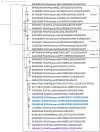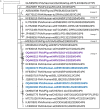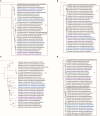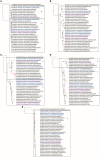Interspecies transmission of porcine-originated G4P[6] rotavirus A between pigs and humans: a synchronized spatiotemporal approach
- PMID: 37283926
- PMCID: PMC10239803
- DOI: 10.3389/fmicb.2023.1194764
Interspecies transmission of porcine-originated G4P[6] rotavirus A between pigs and humans: a synchronized spatiotemporal approach
Abstract
As a leading viral cause of acute gastroenteritis in both humans and pigs, rotavirus A (RVA) poses a potential public health concern. Although zoonotic spillover of porcine RVA strains to humans is sporadic, it has been detected worldwide. The origin of chimeric human-animal strains of RVA is closely linked to the crucial role of mixed genotypes in driving reassortment and homologous recombination, which play a major role in shaping the genetic diversity of RVA. To better understand how genetically intertwined porcine and zoonotic human-derived G4P[6] RVA strains are, the present study employed a spatiotemporal approach to whole-genome characterization of RVA strains collected during three consecutive RVA seasons in Croatia (2018-2021). Notably, sampled children under 2 years of age and weanling piglets with diarrhea were included in the study. In addition to samples tested by real-time RT-PCR, genotyping of VP7 and VP4 gene segments was conducted. The unusual genotype combinations detected in the initial screening, including three human and three porcine G4P[6] strains, were subjected to next-generation sequencing, followed by phylogenetic analysis of all gene segments, and intragenic recombination analysis. Results showed a porcine or porcine-like origin for each of the eleven gene segments in all six RVA strains. The G4P[6] RVA strains detected in children most likely resulted from porcine-to-human interspecies transmission. Furthermore, the genetic diversity of Croatian porcine and porcine-like human G4P[6] strains was propelled by reassortment events between porcine and porcine-like human G4P[6] RVA strains, along with homologous intragenotype and intergenotype recombinations in VP4, NSP1, and NSP3 segments. Described concurrent spatiotemporal approach in investigating autochthonous human and animal RVA strains is essential in drawing relevant conclusions about their phylogeographical relationship. Therefore, continuous surveillance of RVA, following the One Health principles, may provide relevant data for assessing the impact on the protectiveness of currently available vaccines.
Keywords: Croatia; G4P[6]; domestic pig; human; reassortment; recombination; rotavirus A; zoonosis.
Copyright © 2023 Kunić, Mikuletič, Kogoj, Koritnik, Steyer, Šoprek, Tešović, Konjik, Roksandić Križan, Prišlin, Jemeršić and Brnić.
Conflict of interest statement
The authors declare that the research was conducted in the absence of any commercial or financial relationships that could be construed as a potential conflict of interest.
Figures




References
-
- Bányai K., Martella V., Jakab F., Melegh B., Szücs G. (2004). Sequencing and phylogenetic analysis of human genotype P[6] rotavirus strains detected in Hungary provides evidence for genetic heterogeneity within the P[6] VP4 gene. J. Clin. Microbiol. 42, 4338–4343. 10.1128/JCM.42.9.4338-4343.2004 - DOI - PMC - PubMed
-
- Chang K. S., Kim Y., Saif L. J. (2012). “Rotavirus and reovirus,” in Diseases of Swine, eds. J. J., Zimmerman, L. A., Karriker, A., Ramirez, K. J., Schwartz, G.W., Stevenson (United Kingdom: Wiley-Blackwell; ) 621–634.
LinkOut - more resources
Full Text Sources
Research Materials

